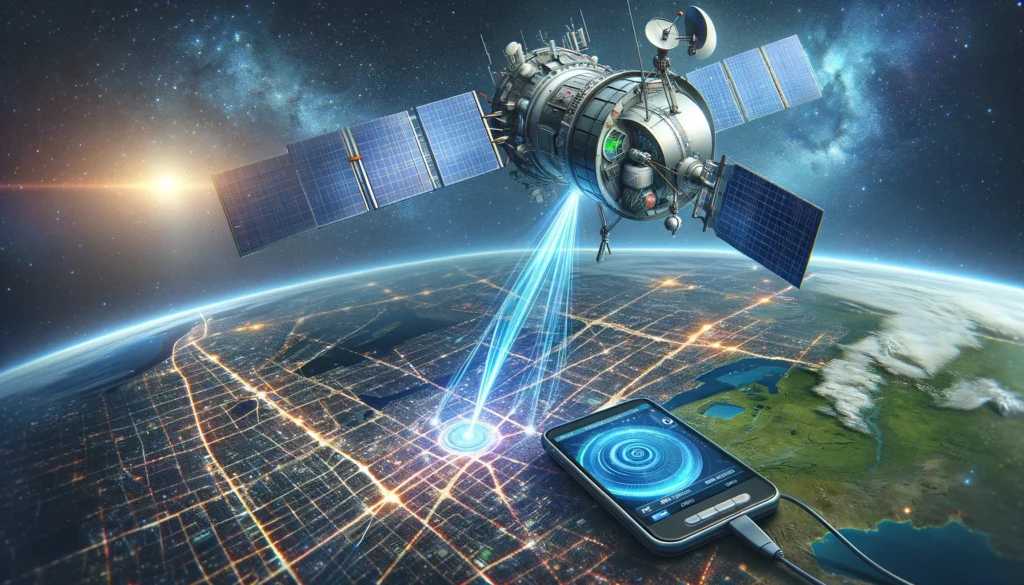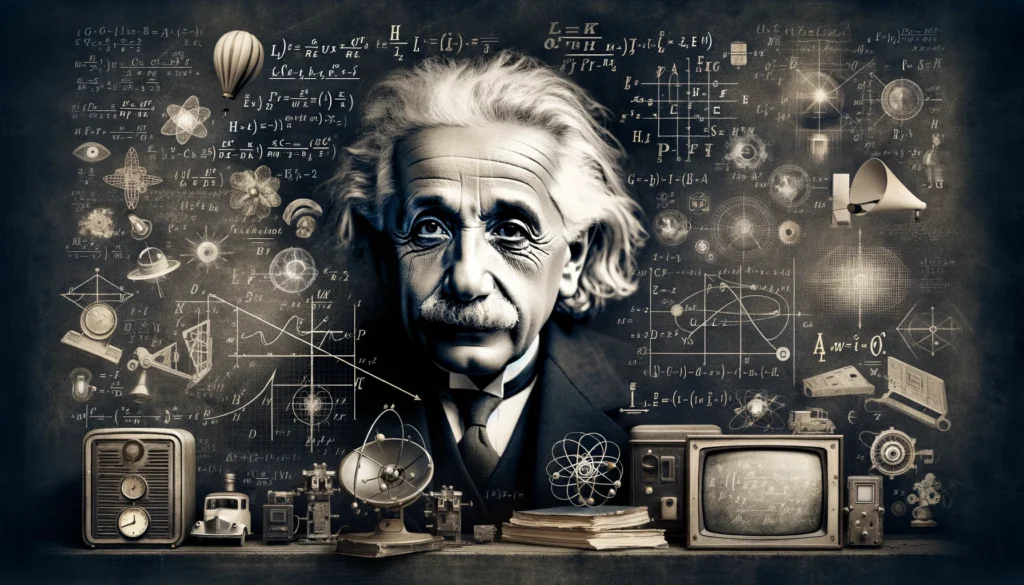When we hear the term “relativity,” our minds often conjure images of Albert Einstein and complex astronomical phenomena. However, the principles of relativity are not just abstract concepts reserved for theoretical physicists; they are integral to the functioning of many technologies we use daily.
This blog post will demystify the theory of relativity, moving it from the realm of cosmic oddities to the concrete world of everyday life. We’ll explore how Einstein’s groundbreaking work has become a cornerstone for modern technology, affecting everything from the accuracy of your smartphone’s GPS to the way we harness energy and communicate across the globe.
By understanding relativity, we can appreciate not just the vastness of the cosmos, but also the incredible technological advancements that have been made possible by embracing these once-unthinkable ideas. Join us on a journey through the fabric of space-time, right from the comfort of your daily routine.
Unraveling the Fabric of Space-Time: The Basics of Relativity
At its core, relativity is about the relationship between space, time, and speed. Albert Einstein revolutionized our understanding of these concepts with two theories: Special Relativity and General Relativity. Special Relativity, introduced in 1905, posits that the laws of physics are the same for all non-accelerating observers and that the speed of light in a vacuum is constant, regardless of the observer’s speed. This leads to fascinating phenomena such as time dilation, where time moves slower for an object in motion compared to one at rest, as observed in high-speed travel scenarios.

General Relativity, proposed in 1915, extends these ideas to include gravity, describing it not as a force, but as the curvature of space-time caused by mass and energy. This theory predicts extraordinary behaviors of celestial bodies and the flow of time in strong gravitational fields, which, while seemingly distant from everyday experience, have practical implications in technologies we rely on daily.
In the following sections, we’ll explore how these mind-bending concepts of time dilation and space-time curvature are not just theoretical musings but are integral to the GPS technology in your smartphone, the reliability of satellite communications, and even the future of travel and energy.
Navigating the World: Relativity and GPS Technology
The Global Positioning System (GPS), a network of about 30 satellites orbiting Earth, is a perfect example of relativity at work in our everyday lives. These satellites continuously send signals that allow our devices to calculate precise locations. But here’s where relativity comes into play: the satellites are moving at high speeds and are far from Earth’s surface, which means the effects of both special and general relativity are significant.

Special relativity predicts that objects moving at high speeds experience time more slowly compared to objects at rest. For the GPS satellites whizzing around Earth at about 14,000 kilometers per hour, their onboard clocks tick slightly slower than clocks on the surface of Earth. On the flip side, general relativity tells us that clocks closer to a massive object (like Earth) tick slower than clocks further away. So, for the GPS satellites orbiting at an altitude of approximately 20,200 kilometers, their clocks actually tick faster due to the weaker gravitational field compared to Earth’s surface.
These differences are not merely academic; if uncorrected, they would lead to a GPS location drift of about 10 kilometers per day! Thus, the GPS system must account for these relativistic effects to provide the pinpoint accuracy we depend on. Engineers correct the satellite clocks to match Earth-based clocks, ensuring that the system keeps us on the right path, whether we’re navigating to a nearby café or embarking on a cross-country adventure.
Keeping Connected: Relativity in Telecommunications
In today’s interconnected world, telecommunications systems like mobile phones and the Internet are essential for our daily communication, business, and entertainment. These systems rely on the precise timing of electronic signals, which are affected by relativistic principles. For instance, the network of satellites that enable global communication must synchronize their clocks to account for relativistic time dilation effects, similar to those affecting GPS systems.

Moreover, the fiber optic cables that form the backbone of the Internet also demonstrate relativistic effects. As light travels through these cables, the principles of special relativity come into play. According to Einstein’s theory, nothing can travel faster than the speed of light in a vacuum. However, in mediums like fiber optic cables, light actually travels slower than this cosmic speed limit. The time delay, although incredibly small, can accumulate over long distances and must be considered to maintain the integrity and speed of data transmission across the globe.
These examples underscore the significance of relativity in ensuring the seamless operation of our telecommunications infrastructure. Without accounting for these relativistic effects, the synchronization necessary for our global communications network to function effectively would be impossible.
Powering Our World: Relativity and Energy Production
The connection between relativity and energy is famously encapsulated in Einstein’s equation E = mc2, which states that energy (E) and mass (m) are interchangeable; they are different forms of the same thing, with the conversion factor being the square of the speed of light (c2). This equation is not just a theoretical statement but a practical reality in the process of nuclear fusion and fission, which powers the sun and provides a significant portion of the world’s electricity through nuclear reactors.

In nuclear reactors, tiny amounts of mass are converted into vast quantities of energy, a process that is directly governed by E = mc2. For instance, in nuclear fission, when a uranium nucleus splits, it loses a small amount of mass. This lost mass is converted into a large amount of energy, powering everything from cities to spacecraft. Similarly, in the sun, hydrogen nuclei fuse to form helium, releasing energy in the process that eventually reaches Earth as sunlight, driving photosynthesis and forming the basis of most of the planet’s energy systems.
Relativity’s role in these processes is fundamental, not merely for understanding how energy is produced but also for calculating the precise amounts of energy released. These calculations are crucial for the design and operation of nuclear power plants and for understanding the life cycles of stars, including our sun.
Timing is Everything: Relativity in Electronics and Timekeeping
In the realm of high-precision timekeeping, relativity plays a critical role. Atomic clocks, which are the most accurate timekeeping devices known, rely on the regular oscillations of atoms to mark time. However, these oscillations can be affected by relativistic effects. For example, according to general relativity, time passes more slowly in stronger gravitational fields. This means that an atomic clock on the surface of Earth, where gravity is stronger, will tick more slowly compared to one in space.

This relativistic time dilation is not just a theoretical curiosity; it has practical implications for the synchronization of global timekeeping networks. The International System of Units (SI) defines the second based on the oscillation frequency of cesium atoms, measured by atomic clocks. To ensure consistency in timekeeping, clocks around the world must account for the relativistic effects of Earth’s gravity, as well as the velocities at which these clocks are moving relative to each other.
Moreover, in the realm of electronics, especially in the semiconductor industry, relativistic effects influence the behavior of particles at nanoscale dimensions. Engineers designing circuits at these scales must consider these effects to ensure the performance and reliability of semiconductor devices.
Beyond the Horizon: Relativity in Scientific Research and Innovation
Relativity has not just reshaped our understanding of the universe; it has paved the way for numerous scientific breakthroughs and technological advancements. In the realm of particle physics, for example, the Large Hadron Collider (LHC) at Conseil Européen pour la Recherche Nucléaire, which translates to the European Organization for Nuclear Research (CERN) uses principles of relativity to accelerate particles to near the speed of light, allowing scientists to observe phenomena that only occur at these extreme energies and speeds. These experiments have led to the discovery of new particles, like the Higgs boson, deepening our understanding of the fundamental building blocks of the universe.

In the field of astronomy, relativity is crucial for interpreting the signals received from distant cosmic phenomena. The study of gravitational waves, ripples in the fabric of spacetime predicted by Einstein’s theory of general relativity, has opened new avenues for observing and understanding the universe. The detection of these waves from colliding black holes and neutron stars has provided insights into these enigmatic objects and the dynamic nature of the cosmos.
Additionally, relativity has practical applications in technologies like magnetic resonance imaging (MRI) and other medical imaging techniques. The principles of relativity influence the behavior of particles in strong magnetic fields, which is fundamental to the operation of MRI machines. This has revolutionized diagnostic medicine, allowing for detailed imaging of internal body structures and functions.
Seeing the Universe Through Einstein’s Eyes: Relativity and Astronomy
Albert Einstein’s theory of relativity has dramatically changed the field of astronomy, providing the framework to understand cosmic phenomena that would otherwise be inexplicable. One of the most striking effects of relativity in astronomy is gravitational lensing, a phenomenon that occurs when the gravitational field of a massive object, like a galaxy or black hole, bends the path of light coming from a more distant object behind it. This effect, which is akin to viewing the universe through a giant cosmic lens, has allowed astronomers to observe distant galaxies, study the distribution of dark matter, and test the predictions of general relativity on a grand scale.

Moreover, relativity has been instrumental in our understanding of the life cycle of stars, the behavior of neutron stars and black holes, and the expansion of the universe itself. For instance, the concept of black holes, regions of space where gravity is so strong that nothing, not even light, can escape, comes directly from the equations of general relativity. Observations of these enigmatic objects, including the recent imaging of a black hole’s event horizon, provide compelling evidence of relativity’s predictions.
The expansion of the universe, first observed by Edwin Hubble and later explained by the Big Bang theory, is another cornerstone of modern astronomy that relies on general relativity. The theory predicts how the fabric of space-time expands, carrying galaxies with it and leading to the observable redshift of distant celestial objects.
Everyday Phenomena: The Unseen Influence of Relativity
While relativity may seem like a concept reserved for cosmic scales and high-tech applications, its influence extends into various facets of our daily experiences. For instance, consider the phenomenon of gravity. Our very experience of weight and motion is dictated by the warping of space-time caused by Earth’s mass, a fundamental aspect of general relativity. This gravitational pull is what keeps us grounded and affects everything from the trajectory of a thrown ball to the flow of rivers.

Another everyday example of relativity at work is in the technology of electric generators and motors. These devices operate on principles of electromagnetism, which are closely tied to relativity. The generation of electricity through the movement of a conductor in a magnetic field (and vice versa) reflects the interplay between electric and magnetic fields, a relationship that is fully described by the equations of relativity.
Even the subtle differences in time experienced by people living at different altitudes or traveling at different speeds are manifestations of relativity. For example, someone living on a mountaintop will age slightly faster than someone at sea level, due to the difference in gravitational potential relative to Earth’s center.
These examples underscore how relativity, far from being just an abstract theory, is a fundamental part of the natural order that shapes our everyday world. Its principles affect not only the grand scale of stars and galaxies but also the ordinary, often overlooked aspects of our daily lives.
The Impact on Modern Science: Relativity’s Legacy
Albert Einstein’s theory of relativity has been one of the most transformative ideas in the history of science, fundamentally altering our understanding of the universe and influencing a wide range of scientific fields. Beyond its immediate implications for physics, relativity has had profound effects on astronomy, cosmology, and even chemistry and biology, by changing how scientists conceptualize space, time, and matter.
In astronomy and cosmology, relativity has been essential in explaining phenomena that Newtonian physics could not, such as the precise orbit of Mercury and the bending of light by gravity, evidenced during solar eclipses. It has provided the framework for understanding cosmic events like the collapse of stars into black holes and the expansion of the universe itself. The theory’s predictions about the nature of black holes and gravitational waves were so ahead of their time that it took decades for technology to catch up and provide the empirical evidence to confirm them.

Relativity also intersects with quantum mechanics, forming the basis of particle physics. It has led to the development of the Standard Model, which describes the fundamental particles and forces that constitute the universe. While relativity and quantum mechanics remain distinct in their application to cosmic and atomic scales, respectively, their integration is the holy grail of modern physics, prompting ongoing efforts to formulate a theory of quantum gravity.
Moreover, the principles of relativity have influenced fields beyond physics. In chemistry, relativity explains why gold is yellow and why mercury is liquid at room temperature, as relativistic effects influence the behavior of electrons in heavy elements. In biology, understanding the relativistic effects on the mutations of DNA through cosmic radiation exposure has implications for evolutionary theory and space travel.
Relativity’s legacy in modern science is vast and multifaceted, touching every corner of scientific inquiry and continuing to drive innovation and discovery. Its principles have not only expanded our knowledge of the universe but also challenged and refined our methods of scientific investigation.
Conclusion: Relativity’s Enduring Impact
Relativity, once a revolutionary idea that challenged our understanding of the universe, has become a fundamental pillar of modern science, deeply embedded in the fabric of our daily lives. From enabling precise GPS navigation to enhancing medical imaging techniques, and from powering cities through nuclear energy to defining the very nature of time and space, relativity continues to shape our world in profound ways. Its legacy extends beyond the realms of astrophysics and cosmology, touching the essence of our existence and the technologies we rely on every day.
As we uncover more about the universe, relativity remains a critical tool in our quest for knowledge, proving that our most abstract scientific theories have concrete applications and impacts. It reminds us that the pursuit of understanding the cosmos is not just an academic endeavor but a practical one that has tangible benefits for humanity. In celebrating the centennial milestones of Einstein’s insights, we not only honor the past achievements of physics but also anticipate the future innovations that these principles will inspire.

Author’s Note
This exploration into the realm of relativity in everyday life aims to bridge the gap between abstract scientific theories and tangible experiences. As we traverse through the intricacies of how relativity shapes our world, the intention is to illuminate the unseen yet profound impact of these principles on our daily lives and modern technology. Your feedback and curiosity are what drive us to delve deeper into the mysteries of physics and its intersection with our everyday experiences.
G.C., Ecosociosphere contributor.
References and Further Reading
- “Relativity: The Special and the General Theory” by Albert Einstein – A fundamental text that introduces the core concepts of relativity in Einstein’s own words.
- “The Fabric of the Cosmos: Space, Time, and the Texture of Reality” by Brian Greene – Provides an accessible exploration of space, time, and the texture of reality, delving into the implications of relativity.
- “Black Holes and Time Warps: Einstein’s Outrageous Legacy” by Kip S. Thorne – Discusses the legacies of Einstein’s theories, focusing on the implications for our understanding of the universe.





Comments
I don’t think the title of your article matches the content lol. Just kidding, mainly because I had some doubts after reading the article.
Can you be more specific about the content of your article? After reading it, I still have some doubts. Hope you can help me.
I enjoy your writing style really loving this website .
This web page is mostly a walk-via for all of the data you wanted about this and didn’t know who to ask. Glimpse here, and you’ll undoubtedly uncover it.
Your point of view caught my eye and was very interesting. Thanks. I have a question for you.
Thank you for your sharing. I am worried that I lack creative ideas. It is your article that makes me full of hope. Thank you. But, I have a question, can you help me?
Your point of view caught my eye and was very interesting. Thanks. I have a question for you.
Keep functioning ,splendid job!
Hello, Neat post. There is an issue along with your site in web explorer, would check this?IE still is the marketplace leader and a good section of other folks will leave out your great writing due to this problem.
I’ve learned some new things out of your blog post. One other thing I have noticed is that generally, FSBO sellers can reject people. Remember, they’d prefer to not use your products and services. But if anyone maintain a comfortable, professional partnership, offering aid and remaining in contact for around four to five weeks, you will usually have the ability to win a meeting. From there, a listing follows. Thank you
I pay a quick visit daily a few web sites and information sites to read posts,
except this blog offers quality based posts.
I love your blog.. very nice colors & theme. Did you create this website yourself or did you hire someone to do it
for you? Plz reply as I’m looking to design my own blog and
would like to know where u got this from. kudos
I am really loving the theme/design of your blog. Do you ever run into any web browser compatibility problems? A number of my blog audience have complained about my site not working correctly in Explorer but looks great in Opera. Do you have any ideas to help fix this problem?
Pretty! This was an incredibly wonderful article. Many thanks for providing this info.
Excellent site you’ve got here.. It’s hard to find quality writing like yours nowadays. I honestly appreciate individuals like you! Take care!!
It’s an remarkable article designed for all the internet viewers;
they will take benefit from it I am sure.
Here is my blog post: nordvpn coupons inspiresensation
Heya i am for the primary time here. I came across this board and I find It really useful & it helped me out a lot. I hope to offer one thing back and help others such as you helped me.
I keep listening to the news update talk about getting boundless online grant applications so I have been looking around for the top site to get one. Could you tell me please, where could i get some?